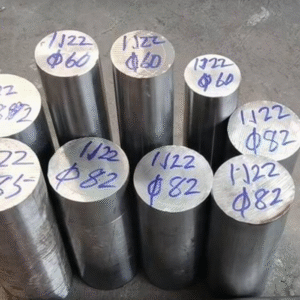Get in touch with us
Leave a message
Discover our premium cobalt based alloys engineered for extreme conditions where standard materials fail. Our portfolio spans from industry-standard Stellite to specialized cobalt chromium formulations, delivering exceptional wear resistance and thermal stability. These high-performance cobalt alloy compositions maintain their properties at elevated temperatures, making them ideal for aerospace, industrial, and medical applications. With tailored nickel-cobalt and chromium-cobalt options, we provide solutions that balance performance requirements with economic considerations.

Cobalt Alloy traces its roots back to the early 20th century when metallurgist Elwood Haynes fused cobalt with chromium, creating a material that resisted oxidation and corrosive environments. Initially dubbed “Stellite” after its star-like luster (from Latin “stella”), this cobalt-based alloy evolved as Haynes identified tungsten and molybdenum as potent strengthening agents. By the 1930s, cobalt chromium alloys like Vitallium were developed for dental prosthetics, later expanding into gas turbines and biomedical implants. Over decades, Cobalt Alloy has progressed from a niche discovery to a cornerstone of modern engineering, with advancements in composition and manufacturing refining its properties for diverse applications.
Cobalt Alloy is standardized under specifications like ASTM F75, F799, F1537, F90, and F562, each defining grades suited to specific uses. For instance, ASTM F75 governs cast cobalt-chromium-molybdenum (CoCrMo) alloys for biomedical implants, while ASTM F562 covers wrought cobalt-nickel-chromium-molybdenum (CoNiCrMo) variants. Classifications split Cobalt Alloy into cast and wrought types, with grades like Stellite 6 and Cobalt 6 emphasizing wear resistance. These standards ensure consistency in composition, mechanical properties, and performance across industries.
Cobalt Alloy typically comprises cobalt (Co) as the base metal (50-65%), blended with chromium (Cr, 20-30%) for corrosion resistance, and smaller amounts of molybdenum (Mo, 5-10%), tungsten (W, up to 15%), nickel (Ni, 0-35%), and carbon (C, 0.1-0.8%). Trace elements like iron (Fe), silicon (Si), and manganese (Mn) may also appear. For example, Stellite alloys lean heavily on cobalt, chromium, and tungsten, while biomedical CoCrMo alloys prioritize molybdenum for strength and biocompatibility.
| Type | Composition | Properties | Common Variants |
|---|---|---|---|
| Cobalt Chromium Alloy | Co (60%), Cr (28%), Mo (6%) | High corrosion resistance, strength | ASTM F75, Vitallium |
| Cobalt Chrome | Co (54%), Cr (21%), W (16%) | Wear resistance, heat tolerance | Stellite 6, Alloy L605 |
| Nickel Cobalt Alloy | Co (35%), Ni (35%), Cr (20%) | Ductility, corrosion resistance | MP35N, ASTM F562 |
| Cobalt 6 | Co (bal.), Cr (28%), W (4-6%) | Extreme wear resistance | Stellite 6 |
| Property | Description | Influencing Elements | Performance |
|---|---|---|---|
| Corrosion Resistance | Forms a Cr2O3 passive film | Cr, Mo | Excellent in acids, saltwater |
| Oxidation Resistance | Stable at high temperatures | Cr, W | Superior up to 1000°C |
| Magnetism | Ferromagnetic | Co | Strong in magnetic alloys |
| Heat Resistance | Retains integrity in extreme heat | Co, Ni, W | Outperforms Ni alloys >930°C |
Cobalt Alloy excels in harsh conditions, resisting sulfidation and oxidation better than nickel-based alloys, thanks to its high chromium content.
Cobalt Alloy boasts impressive physical attributes, often surpassing alternatives like stainless steel or nickel alloys. Here’s a comparison:
| Property | Cobalt Alloy | Stainless Steel | Nickel Alloy |
|---|---|---|---|
| Tensile Strength | 145-270 MPa | 500-700 MPa | 600-1000 MPa |
| Hardness | 550-800 MPa | 150-300 MPa | 200-500 MPa |
| Ductility | Low (brittle) | High | Moderate |
| Melting Point | ~1330-1495°C | ~1400-1450°C | ~1455°C |
While Cobalt Alloy sacrifices ductility for hardness, its strength at elevated temperatures outshines competitors, making it ideal for high-stress environments.
Cobalt Alloy serves industries requiring durability and resistance:
Its versatility makes Cobalt Alloy a go-to material for extreme conditions.
Despite its strengths, Cobalt Alloy has limitations:
These factors require careful consideration in design and application.
Cobalt Alloy’s corrosion resistance stems from its chromium-rich passive layer (Cr2O3). Tests show corrosion current densities as low as 0.36 µA cm⁻² for laser-printed CoCr after 100 hours in saline, outperforming cast variants (0.87 µA cm⁻²). Factors like carbon content (high levels reduce resistance via carbide precipitation) and microstructure homogeneity (wrought beats cast) influence performance. It thrives in acidic and high-temperature environments but may falter in chloride-heavy settings if not alloyed properly.
Welding Cobalt Alloy requires precision:
These approaches ensure Cobalt Alloy retains its integrity during fabrication.



A: Cobalt Alloy offers superior performance at elevated temperatures, maintaining its strength and corrosion resistance where stainless steel would soften and degrade. It also provides better wear resistance and higher hardness, particularly in high-temperature environments above 650°C.
A: Most cobalt-based alloys are either non-magnetic or only slightly magnetic at room temperature, depending on their specific composition. This property makes them suitable for applications where magnetic interference must be minimized.
A: The primary limitations include higher cost compared to stainless steels and nickel alloys, limited machinability requiring specialized tooling and techniques, and the strategic nature of cobalt as a raw material which can affect supply availability.
A: Cobalt alloys exhibit excellent resistance to seawater corrosion, particularly pitting and crevice corrosion. Their performance in marine environments typically exceeds that of standard stainless steels, making them ideal for critical marine components despite their higher cost.
A: The primary industries utilizing cobalt alloys include aerospace (turbine components), medical (implants and prosthetics), power generation (gas turbines), oil and gas (downhole tools and valves), and cutting tools manufacturing.
A: Yes, Cobalt Alloys are highly recyclable with recovery rates exceeding 90% in industrial applications. Our recycling program helps minimize environmental impact while conserving valuable resources.

Professional manufacturer of premium specialty alloys, offering stainless steel, Hastelloy, nickel-based alloys and processing services. Delivering superior metallurgical solutions for aerospace, petrochemical, marine engineering and other demanding industries.
©2025 alloy-materials.com COPYRIGHT ALL RIGHT RESERVED.